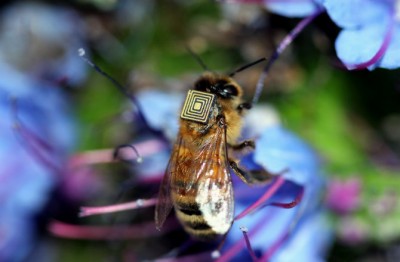
Image source: Discovery.com
Honeybees in Australia are about to be outfitted with tiny sensors so their movements can be monitored. Researchers are hoping the technique, known as “swarm sensing,” will shed light onto the colony collapse disorder problem and help discover how the bees navigate.
The world’s first such research program is led by CSIRO, Australia’s national science agency. The project seeks to enhance honeybee pollination activity on farms, as well.
Approximately 5,000 sensors are going to be fitted onto the backs of honeybees in Hobart, Tasmania. The bees will then be released into the wild for environmental monitoring. Never before has such a massive number of insects been involved with a sensor tracking program.
The CSIRO devices are small radio frequency identification sensors that function similar to the same way a vehicle’s “e-tag” does when it passes a checkpoint, according to researchers. The information collected by the sensors is sent to a central location for review and compilation. The data is expected to allow the scientists to build a three-dimensional model which will then create a visual diagram of how the bees move about the landscape in their natural environment.
The University of Tasmania and the Tasmanian Beekeepers Association are working with CSIRO on the bee sensors project. Before the swarm sensors can be attached, the honeybees must be refrigerated for a short period of time. The cold puts the bees into a rest state just long enough for the sensors to be secured to their backs. After several minutes, the honeybees wake up, ready to head back to their hive. Dr. de Souza said the process is not destructive to the insects and they are perfectly capable of flying and carrying out normal activities.
New Survival Seed Bank™ Lets You Plant A Full Acre Crisis Garden!
Said CSIRO program leader Dr. Paulo de Souza:
Honeybees play a vital role in the landscape through a free pollination service for agriculture, which various crops rely on to increase yields. A recent CSIRO study showed bee pollination in Faba beans can lead to a productivity increase of 17 percent. Around one third of the food we eat relies on pollination, but honeybee populations around the world are crashing because of the dreaded Varroa mite and Colony Collapse Disorder. Many growers rely on wild bees or the beekeepers to provide them with pollinators so they can improve their crops each year. Understanding optimal conditions for these insects will improve this process.
The swarm-sensing project will also delve more deeply into the possible negative impact chemical pesticides have on honeybees. As previously reported by Off The Grid News, Monsanto’s Roundup Ready and similar agricultural products by other members of the biotech industry have been touted as the primary cause of colony collapse disorder.
Said gardening author and beekeeper Rick Austin:
Nature doesn’t have pesticides or fertilizers, and we have had berry bushes and fruit trees without any help or intrusion from man for centuries. Turning soil over is another bad idea, because it loses nutrients. Planting in straight rows is also not a good idea. Mechanized farming has been around since about WWII. Chemical companies which made bombs for the war effort grew fast and ultimately found themselves with nothing to do after World War II ended – then along came fertilizer. Chemical companies told farmers that fertilizer would help grow more plants more quickly in the same space, instead of letting nature take its course. Monsanto products run counter to nature. They have created a self-fulfilling prophecy and reason for existence. Weeds resistant to Roundup now require the use of even more of the herbicide to kill the weeds. Those chemical are going into plants, soils, and the foods that we eat.
Dr. de Souza also noted that honeybees are “social insects” which come back to the same spot on a fairly predictable schedule. A change in their routine reportedly indicates some type of environmental change. Neonicotinoids, one of the primary components of multiple chemical pesticides, has been blamed for causing problems to the bee nervous system. If the claims are accurate, a honeybee becomes too confused to find its hive and possible food sources. Neonicotinoids may also cause the insects to become lethargic, essentially forcing them to “forget to eat” and the ones which do make it back to the hive simply starve themselves to death.
Sign up for Off The Grid News’ weekly email and stay informed about the issues important to you
 Off The Grid News Better Ideas For Off The Grid Living
Off The Grid News Better Ideas For Off The Grid Living




